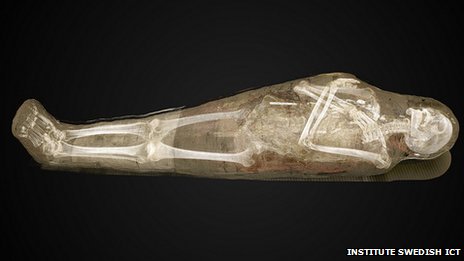A museum in Sweden will digitise its mummy collection in 3D
A museum in Sweden will digitise its mummy collection in 3D to allow visitors to unwrap a real mummy in digital form.
The mummies from Medelhavsmuseet in Stockholm will be digitised by technology which uses photos and X-ray scans to create 3D models.
The permanent exhibition is scheduled to open in the spring of 2014.
The curators hope it will help visitors gain a deeper understanding into the lives of ancient Egyptian people.
The museum will scan six mummies using a process called reality capture technology, where high-resolution 3D digital models can be made by compiling data from photos and X-ray scans.
Museum visitors will be able to explore the mummies in a way similar to what archaeologists do when they are looking for novel discoveries from ancient remains."We aim to set a new standard for how museums work with 3D digitisation and interactive visualisation to make collections more accessible to other museums, researchers and museum visitors," said Thomas Rydell of the Swedish Interactive Institute.
"In this project we are working with mummies, but the same methods could of course be used on large variety of objects, such as natural history objects and other historical artefacts."
The museum visitors will be able to zoom into very high resolution to see details like carving marks on a sarcophagus. They will also be able to "unwrap" a mummy by peeling off virtual layers of the wrapping to explore the artefacts buried with the body.
"We can literately create a virtual copy of the mummy. This version could be shared with other museums, be used for research or be part of an interactive visitor experience," added Mr Rydell.The work is a collaboration between Swedish visualisation researchers, Medelhavsmuseet in Stockholm and two technology companies, Autodesk and Faro.
"The technology will enable our visitors to gain a deeper understanding of the men and women inside the mummy wrappings," said Elna Nord, producer of the exhibition.
"Layer by layer, the visitor can unwrap the mummy and gain knowledge of the individual's sex, age, living conditions and beliefs. With help from the technology, the mummies become so much stronger mediators of knowledge of our past."
The mummies from Medelhavsmuseet in Stockholm will be digitised by technology which uses photos and X-ray scans to create 3D models.
The permanent exhibition is scheduled to open in the spring of 2014.
The curators hope it will help visitors gain a deeper understanding into the lives of ancient Egyptian people.
The museum will scan six mummies using a process called reality capture technology, where high-resolution 3D digital models can be made by compiling data from photos and X-ray scans.
Museum visitors will be able to explore the mummies in a way similar to what archaeologists do when they are looking for novel discoveries from ancient remains."We aim to set a new standard for how museums work with 3D digitisation and interactive visualisation to make collections more accessible to other museums, researchers and museum visitors," said Thomas Rydell of the Swedish Interactive Institute.
"In this project we are working with mummies, but the same methods could of course be used on large variety of objects, such as natural history objects and other historical artefacts."
The museum visitors will be able to zoom into very high resolution to see details like carving marks on a sarcophagus. They will also be able to "unwrap" a mummy by peeling off virtual layers of the wrapping to explore the artefacts buried with the body.
"We can literately create a virtual copy of the mummy. This version could be shared with other museums, be used for research or be part of an interactive visitor experience," added Mr Rydell.The work is a collaboration between Swedish visualisation researchers, Medelhavsmuseet in Stockholm and two technology companies, Autodesk and Faro.
"The technology will enable our visitors to gain a deeper understanding of the men and women inside the mummy wrappings," said Elna Nord, producer of the exhibition.
"Layer by layer, the visitor can unwrap the mummy and gain knowledge of the individual's sex, age, living conditions and beliefs. With help from the technology, the mummies become so much stronger mediators of knowledge of our past."



